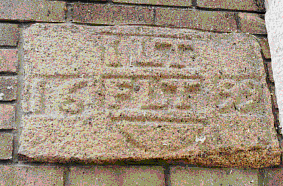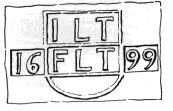

 IPD ETZ 1817 Les Côtils, Rue des Côtils (St H);
IPD ETZ 1817 Les Côtils, Rue des Côtils (St H);

 The carvings may not always appear as a door
lintel, there are dated stones as plaques (see left), arch keystones, corbels
on the gables of houses and gateposts. Some of the lintels are no longer
used as such and have been incorporated into walls, used as garden ornaments,
benches or steps. A word of caution, a few lintels have been moved, ending
up on a house that has no connection with the couple commemorated.
The carvings may not always appear as a door
lintel, there are dated stones as plaques (see left), arch keystones, corbels
on the gables of houses and gateposts. Some of the lintels are no longer
used as such and have been incorporated into walls, used as garden ornaments,
benches or steps. A word of caution, a few lintels have been moved, ending
up on a house that has no connection with the couple commemorated.
The very earliest stones just contain one letter each for the Christian and Surnames and then, from the late 17th Century onwards, the initials were usually based on syllables, so the name Lemprière would be carved as LP and Collas as CL . Therefore a stone commemorating the construction of a house in 1747 for Jean Lemprière and his wife Rachel Collas would usually appear as ILP RCL 1747.
The longer surnames that break up into many syllables - Le Boutillier, for example, should appear as LBTL, differentiating it from Le Breton (LBT) or Le Brun (LB). This is not a hard and fast rule, in several instances the name Le Boutillier has been carved as Le B, probably to save money!
Initials of Christian Names utilised only the first letter - with the
J of Jean carved as an I. The husband's name is always on the left of the
stone. A number of surnames are very distinctive when carved and leap out
at you - Fauvel (FV) and de Ste Croix (DSX), the latter effectively using
the symbol of an X to indicate the whole word Croix. In one or two places
the X has actually been carved at an angle as a cross. Elsewhere another
branch of the family had DSC carved, another indication that  there are always
exceptions to the rule. Le Quesne is carved as Lq - see below - which
had led to many of their family stones being misidentified as LG.
there are always
exceptions to the rule. Le Quesne is carved as Lq - see below - which
had led to many of their family stones being misidentified as LG.
In other instances a surname may contain the same number of syllables, Perchard and Picot, for instance are both carved as PC, and in this case one needs to be aware of the preponderance of these surnames in the parish being researched. Perchard being most common in the east of the Island and Picot in the north. Aubin and Aubert (AB) generally follow the same rule.
The habit has not died out in the 20th Century. Modern stones have also been recorded in this index, the most recent dated 1999. Although Internet sites cannot pretend to be permanent, in due course this register will become a book and the 20th Century stones will become of interest to 21st Century owners of Jersey Houses.
I cannot claim any particularily clever research methods. Driving around keeping my eyes open and knocking on doors just about sums it up! Though I am drawn to houses with 4ft thick granite chimneys, which nearly always seem to feature datestones - except in St Peter!
Most of the stones have been identified using Jersey's Marriage Registers, all of which have been indexed up to 1842 (the start of Civil Registration) and several beyond. Dr Karen Gottlieb's Index of Jersey Marriages 1700-1799 has been invaluable. In instances when a marriage cannot be found, often the couple will have children baptised in their home Parish (or will act as godparents to other children) and can be traced.
Most of the photographs are my own, taken with a Fuji MX-2700 digital camera (2.3 Mega Pixels), contributions from others - including James Brannan and Ray Le Pivert - are acknowledged. Some datestones are to be found among the images preserved by the Société Jersiaise Photographic Archives. I am presently negotiating with them for permission to use the pictures as these datestones have either been lost or have come from properties that have been demolished and are shown in their original location.
 In the case of the stone on the left, the archive was especially useful
as it has moved from St Aubin to Trinity. SD.NLG.1624 was between Trafalgar
Hotel and neighbouring property, Mont Les Vaux, St. Aubin (St B). The picture
shows this stone when it was uncovered in 1986 (Architecture Section
Catalogue 13 a.3.) Labelled as originally at Tenby, Market Hill, St
Aubin (St B) but now at Gracelands, Rue de Croiserie (T). So it has moved
twice!
In the case of the stone on the left, the archive was especially useful
as it has moved from St Aubin to Trinity. SD.NLG.1624 was between Trafalgar
Hotel and neighbouring property, Mont Les Vaux, St. Aubin (St B). The picture
shows this stone when it was uncovered in 1986 (Architecture Section
Catalogue 13 a.3.) Labelled as originally at Tenby, Market Hill, St
Aubin (St B) but now at Gracelands, Rue de Croiserie (T). So it has moved
twice!
All photographs by the author are free of restrictions. Items marked © are used with permission but remain in the copyright of the Stevens family or other contributors and should not be downloaded.
A legend has grown up around datestones with upside down hearts, that
they commemorate a death in the family. There appears to be no
evidence of this in the registers. For example NC KLM.1727. Nicolas Chevalier
m. Katherine Le Montais (St P) 1.2.1717/8; La Retraite a l'Ouest, Beaumont
(St P). This upside down heart does not indicate a death and may just be
a stonemason's error. Nicolas was buried in 1735 and Katherine in 1748.
Reversed letters and numbers have no special significance either. Literacy was not as widespread as it is today and these mistakes may not have been noticed, either by the stonemason or their customers.
 'Official' Stones
'Official' Stones
 Ecclesiastical
Stones
Ecclesiastical
Stones
Please note: the original Arranged by Surname index has now been removed as it is out of date. To search for a surname or house name use your 'FIND' facility in the Text Version: 1-903 | Text Version: 904 onwards.
Arranged by Stone 1-100 | 101-200 | 201-300 | 301-400 | 401-500 | 501-600 | 601-700 | 701-800 | 801-903 | 904-949 | 950-999 | 1000-1050 | 1051-1100 | 1101-1150 | 1151-1200 | 1201-1250 | 1251-1300 | 1301-1350 | 1351-1400 | 1401-1450 | 1451-1500 | 1501-1550 | 1551-1600 | 1601-1650 | 1651-1700 | 1701-1750
Geraint Jenning's Jersey Statues include the Harvey and Westaway Memorials commemorating lives lost at sea.
![]() The Guernsey
Datestones Project moved here from my PSINet site.
The Guernsey
Datestones Project moved here from my PSINet site.
Several Jersey histories make reference to datestones - see Chris
Le Gros' The History
of Le Pied du Cotil - now Hotel Santa Monica (St L) and James
Brannan's Home Page.
Joan Stevens' books are reviewed at Charles Picot's Books
about the Channel Islands.
At John Fuller's Volunteers Page several people offer to undertake Look Ups in these books - myself included. Please provide the full name(s) and the Parish you are interested in when enquiring.
Most of the houses listed in the country Parishes can be found on the Godfray Map of 1849 along with the name of their owner. Now available: The Godfray Map of 1849 Index by Roland de Caen. There is also a volunteer at John Fuller's pages who will scan the appropriate section for you.